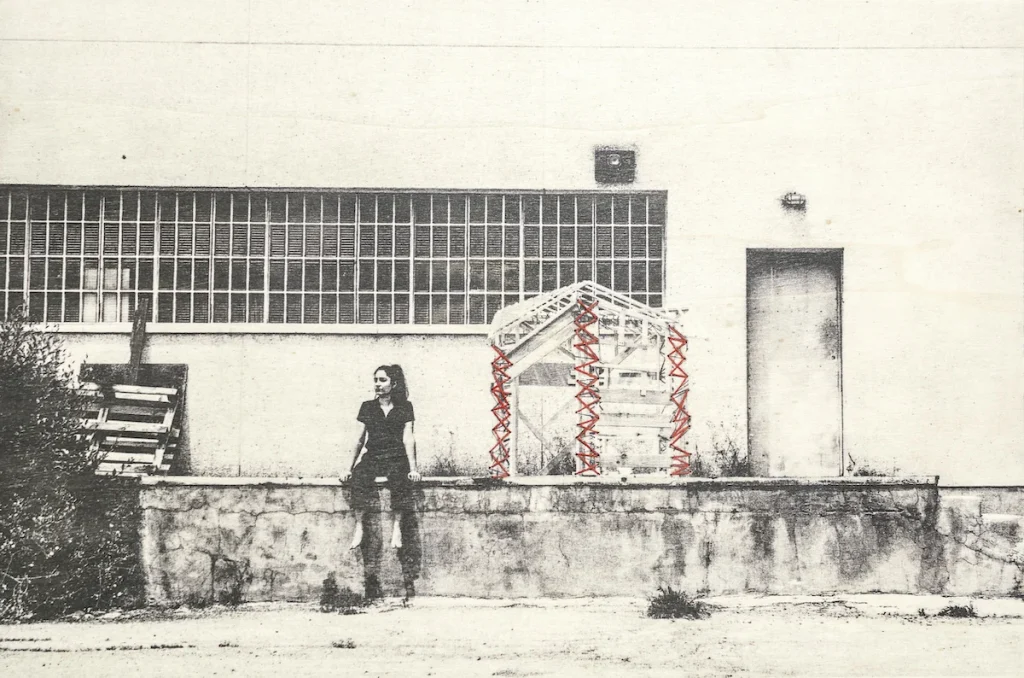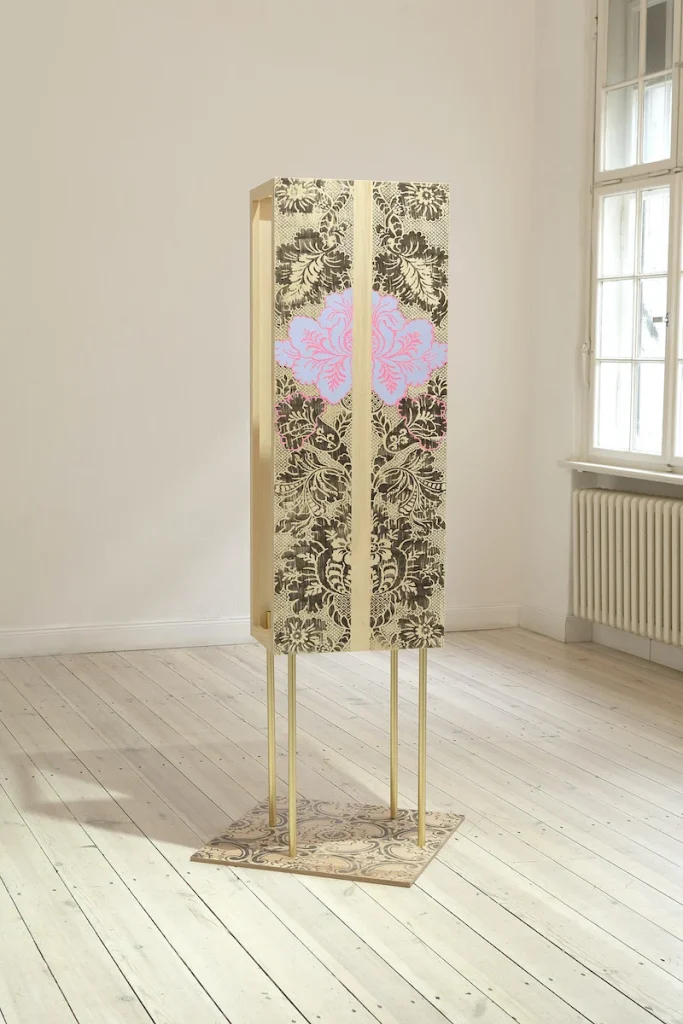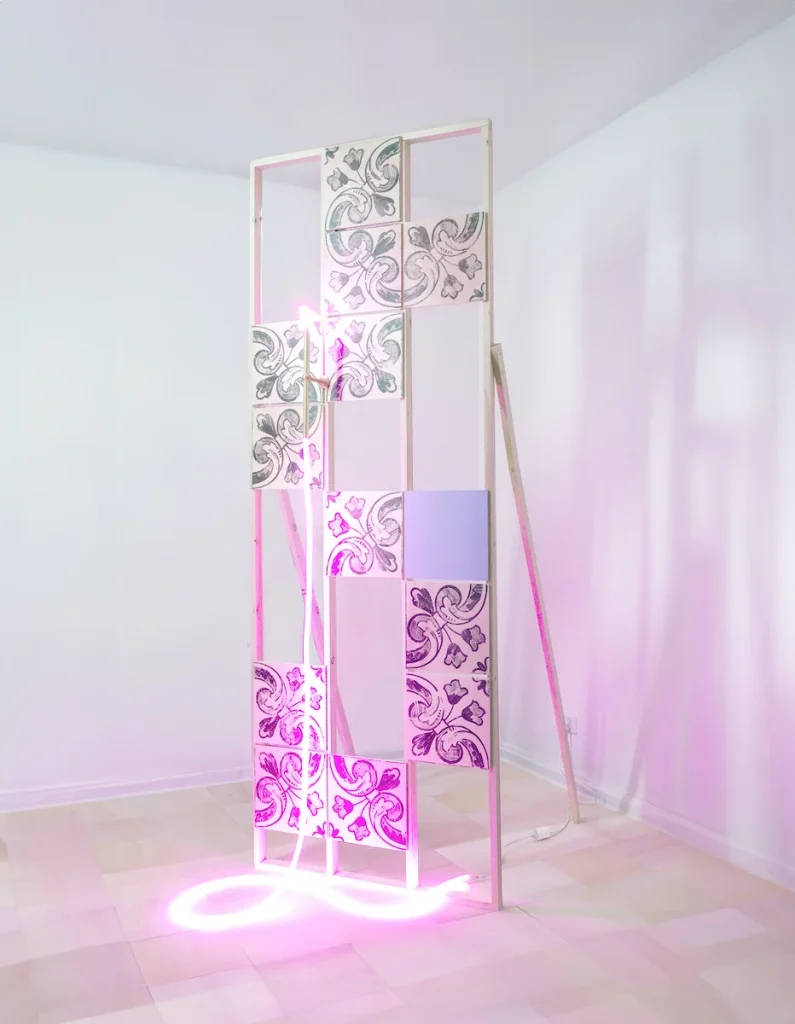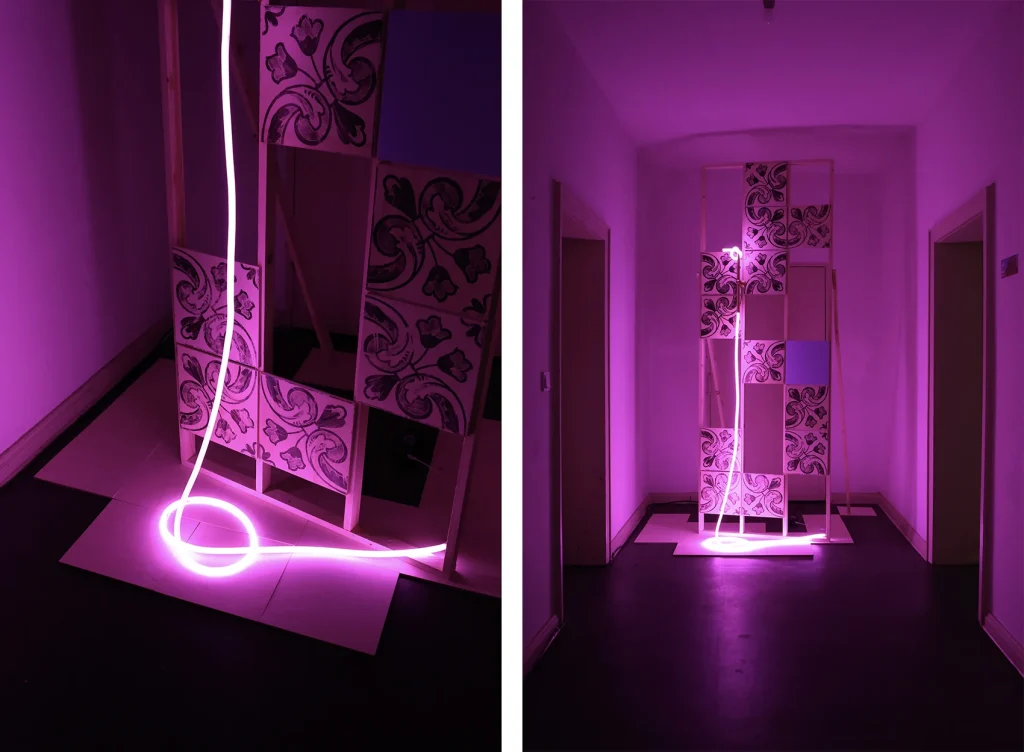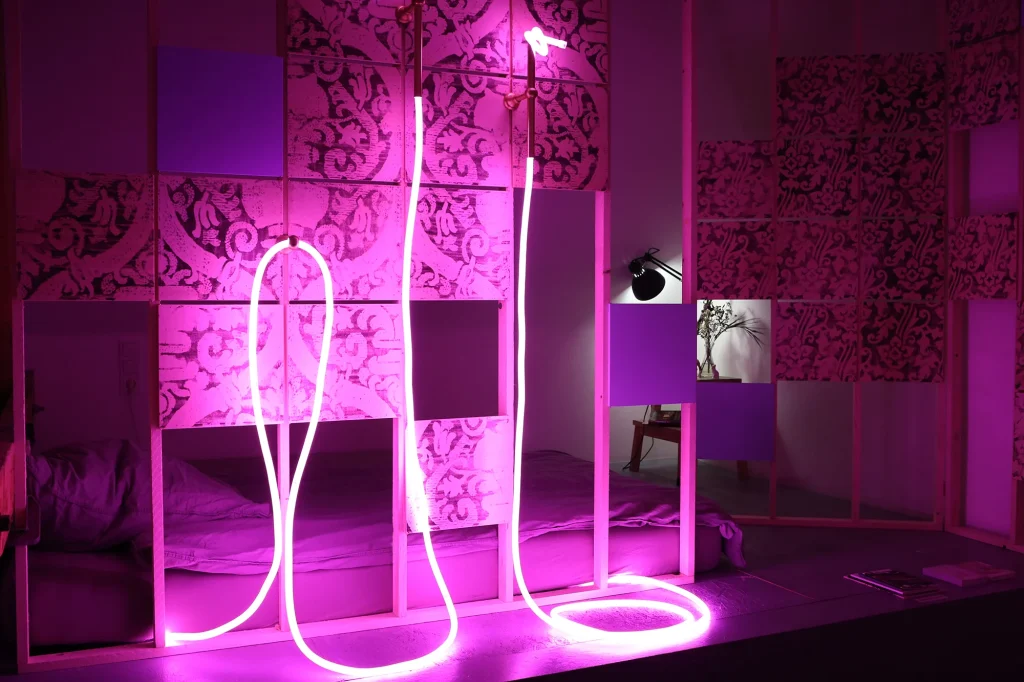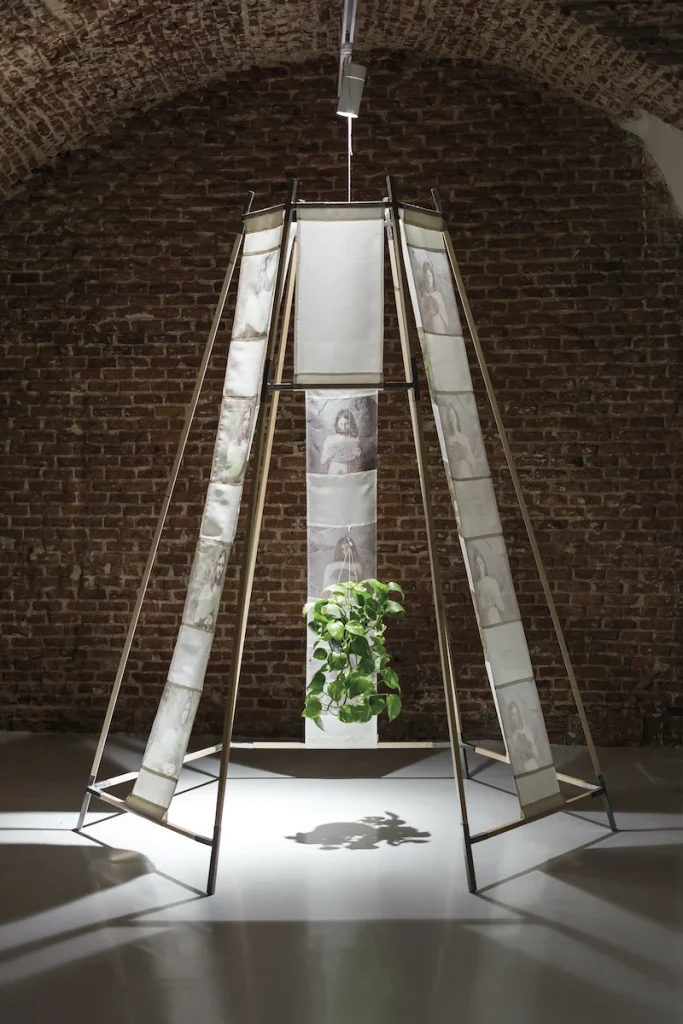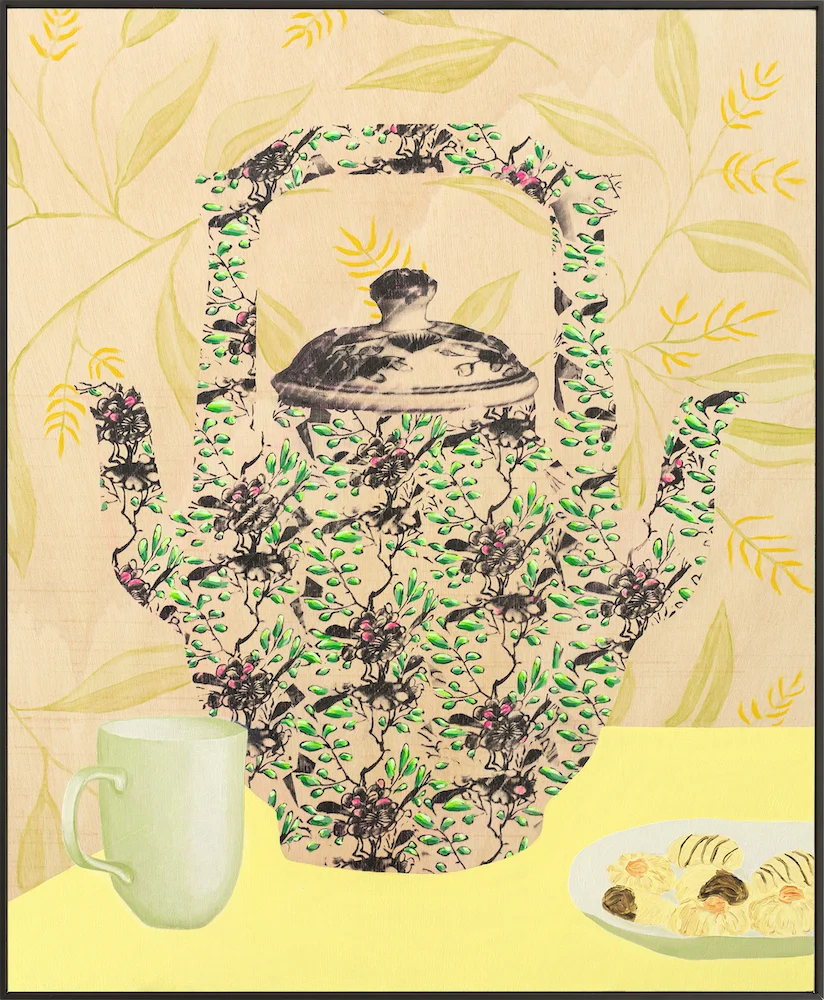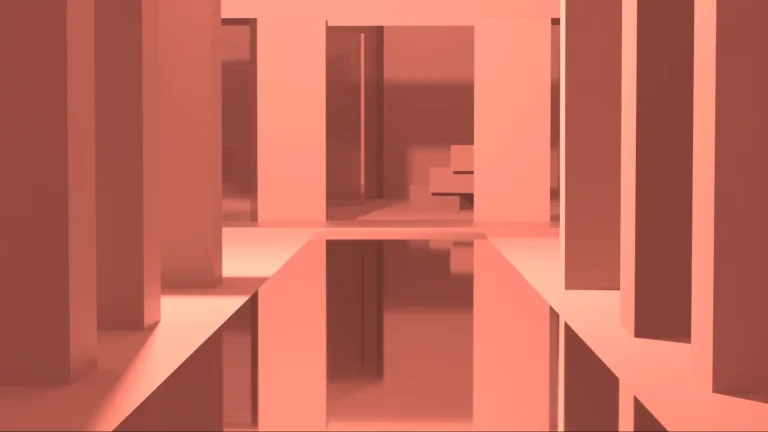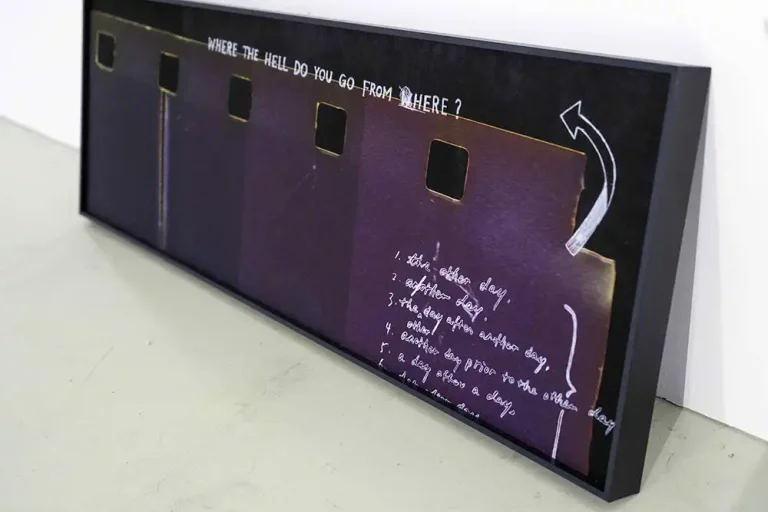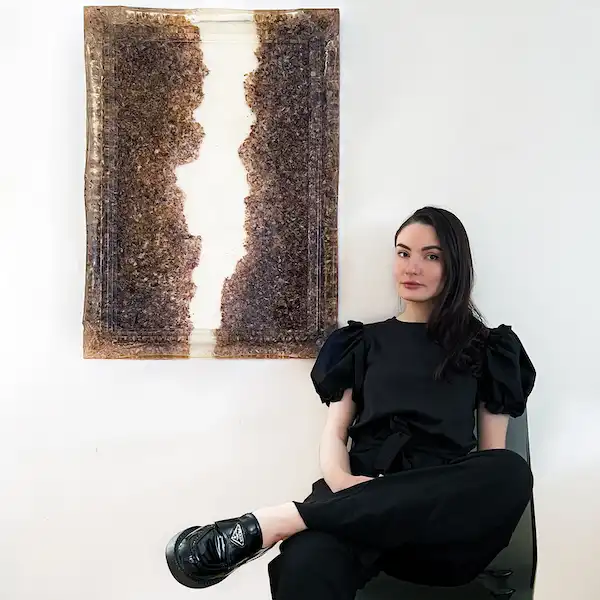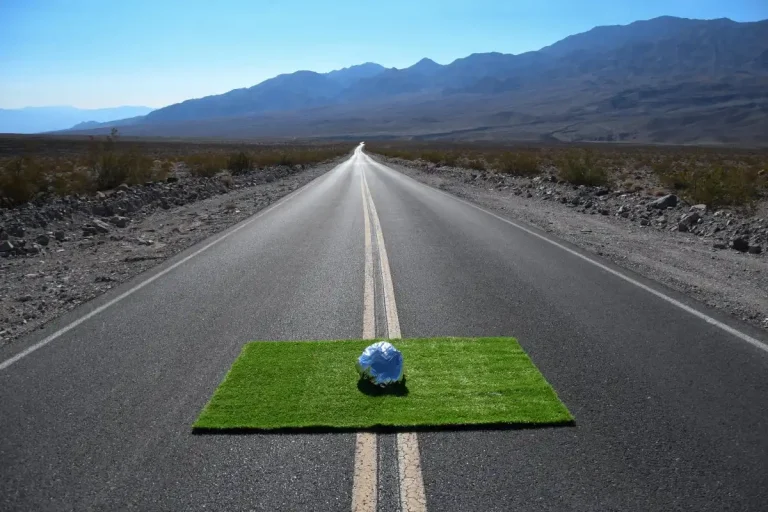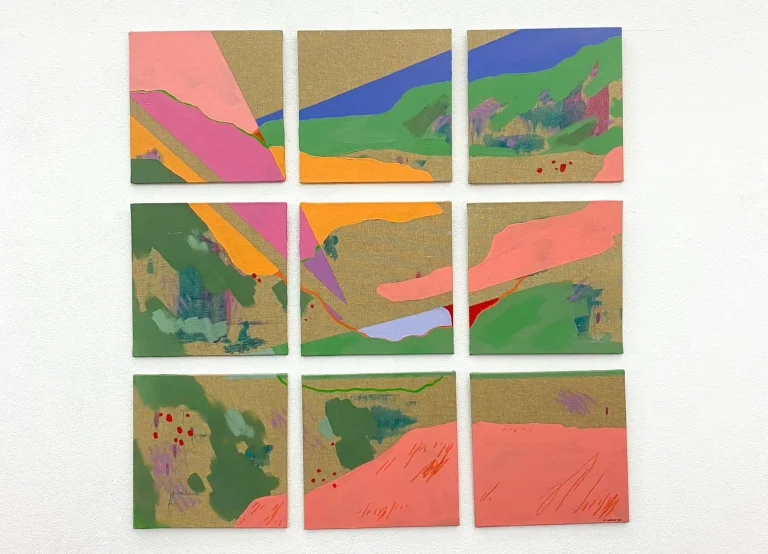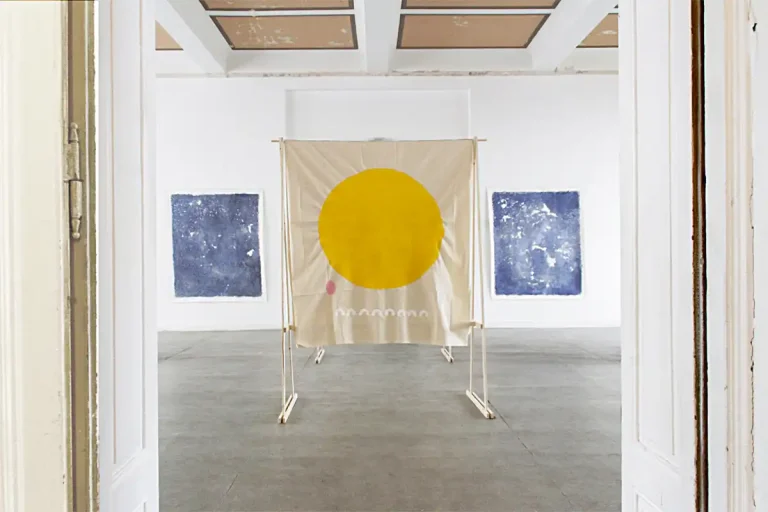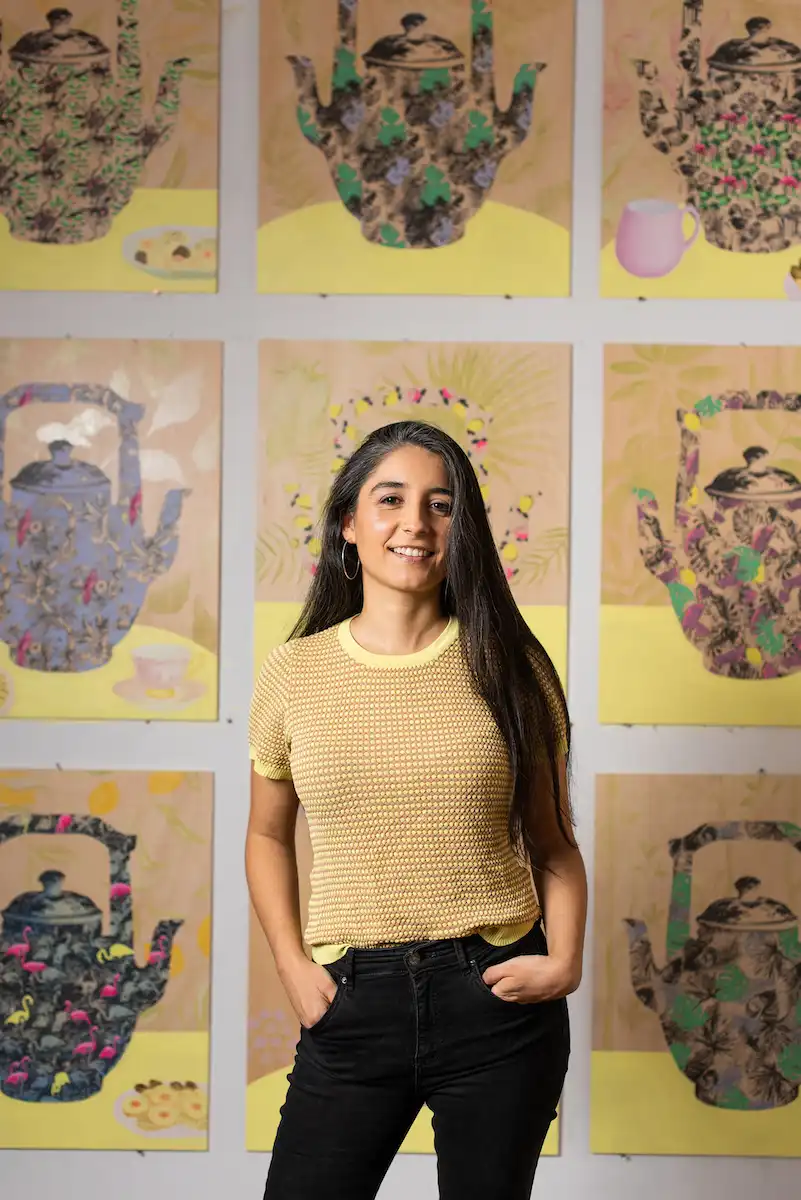
Tamara Jacquin is GlogauAIR resident
from October, 2023 to December, 2023
Tamara Jacquin engages in an interdisciplinary practice that encompasses installation, sculpture, painting, printmaking, textile, video, and photography. Her artistic process is characterised by an additive approach, working in layers, with each layer introducing a new medium to amplify the complexity of the piece. Tamara Jacquin typically initiates her work with a photograph, digitally refining it before transferring it onto fabric or wood.
In her recent artworks, Tamara Jacquin aims to establish a dialogue between two worlds by integrating ancient everyday objects, laden with historical significance. She intertwines these objects with contemporary textures and vibrant colors, situating them within a current context. This deliberate juxtaposition aims to provide fresh insights that connect the past with the present, prompting viewers to contemplate the evolving meanings of these objects over time.
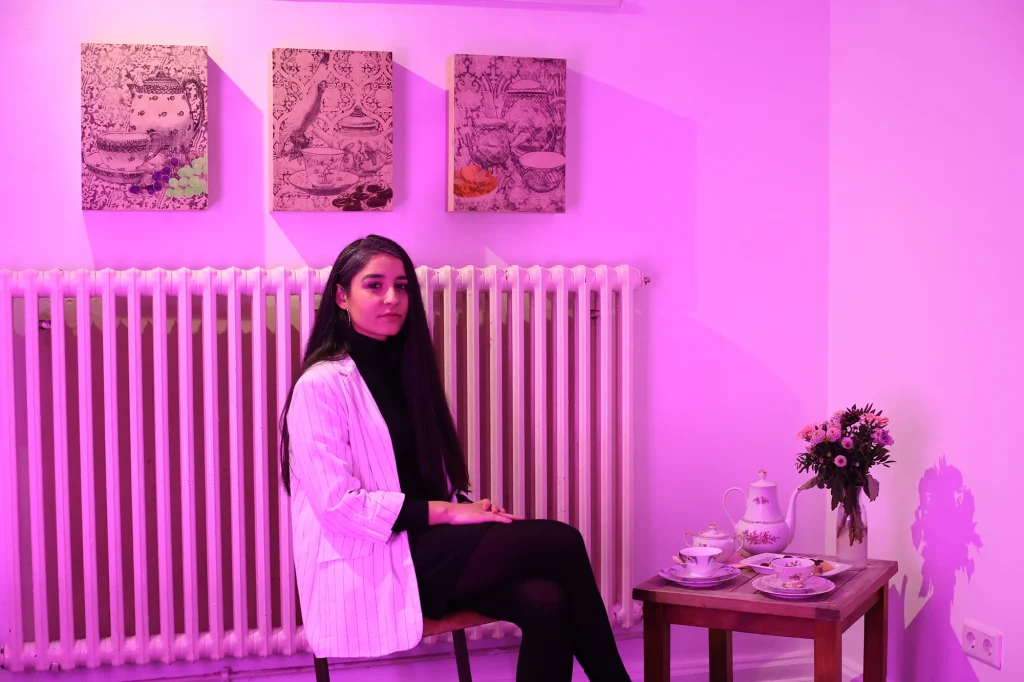
Meet the Artist
Hello Tamara, thanks for having me in your studio!
Tell us, how did you start your artistic journey?
I originally studied architecture. I went to architecture school, and did the whole six years in Chile. I wanted to study art at the beginning, but my parents did not let me, and I chose architecture because it was still related to something artistic. I did an exchange in France for my fifth year, and this changed my perspective of what I wanted to do after I finished my education. I come from a not-so-big city, so growing up I couldn’t just go and easily see art in the museums, and I mostly learnt art from books. Coming to Europe, visiting all these museums in France, like the Centre Pompidou, really inspired me. When I went back and finished my architecture degree one year later, I decided that I wanted to study art.
Did you go to art school after?
I went to art school in Argentina and studied almost three years, but stopped because art school was too long, and I also wanted to leave the country. I decided to go to Spain. I arrived in Valencia in 2013 and I did a master’s degree in fine arts there.
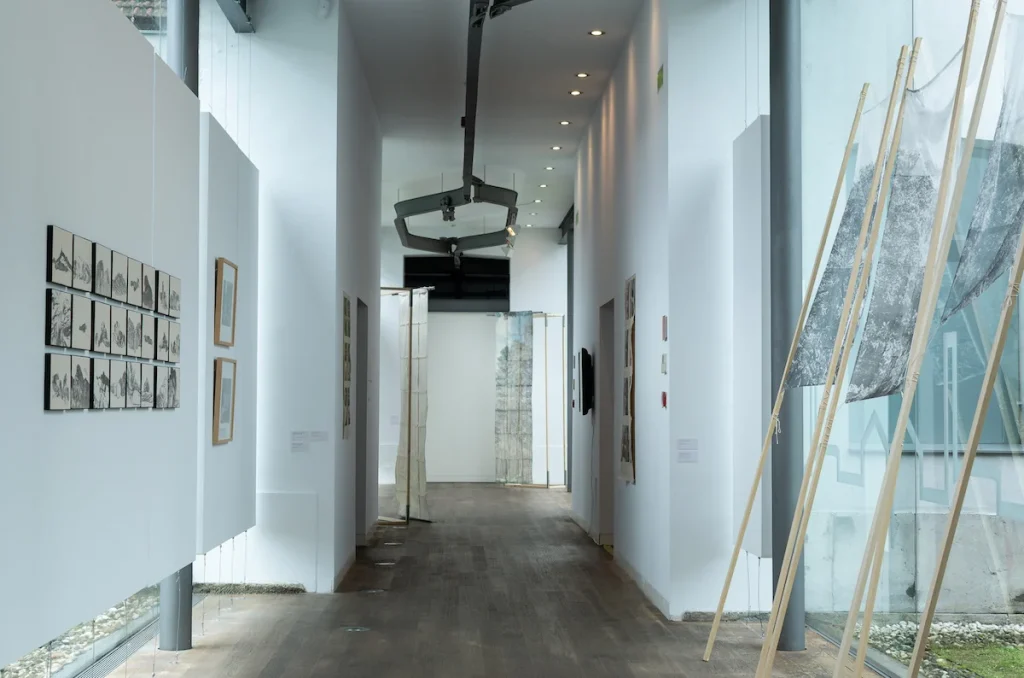
Would you say that because you studied architecture, it is still a big inspiration in your work?
I studied a lot of different things, and it seems like everything I learnt is part of me now. When you’re young and you study for your first career, it really teaches you how to visualise the world, how to open your eyes in a certain way. It stays with you. So yes, I’m a big fan of architecture. I’m really fascinated by different kinds of architecture, different time periods, and I do think they relate to art history too. I mean, it’s all connected. It’s not one thing without the other.
What are your other inspirations?
I’m inspired by many things. I get my inspiration from everyday life, and all the things that are around me. If I’m working in a new city, I like to take walks and be aware of my surroundings, and I go to a lot of museums to look at the art. I’m interested to see how everything evolves, from ancient art to impressionism, to nowadays. Of course I’m also interested in other artists. My first favourite artist was Rebecca Horn. I love her work, and I’m especially inspired by her early projects. My first artworks were inspired by hers. Her pieces present the themes of constructions related to the body, how it moves, etc. For me it was a wonderful discovery.
I also get my inspiration from decorative arts. I love to visit old palaces. It’s so interesting how all these things now live at the same time, you know? Like, things from different times still exist nowadays. And you can just visit these places and see how the time has passed, history has passed, but the objects remain.
You talk about visiting old palaces and finding inspiration in the different decorative objects from the past that you encounter there, is it what inspires your current project?
Yes, that’s what I’m currently working on. Since I arrived in Berlin, I’ve been visiting all the museums, all the palaces, and all the ancient places that I can find. I’m inspired by these objects from different times and periods. It’s like the past is not over because we still live with things from the past. For me, things from the past have an amazing magic: they resisted time. Some of them you can’t have at your house, and you need to visit museums to see them, but still, they survived time, they weren’t just destroyed and forgotten. What I’m doing is that I take these ancient objects or elements from decorative arts and put it in a dialogue with other elements from today, to think about the relation between past and present. It allows me to reflect about how history has changed, and by extension, about the future. You know, when we look at society today, we can be tempted to think things are always going to work this way. But when we look at the past, we know it isn’t true! We have objects and stories to prove the contrary. Now we also have proof that the past and future can coexist, maybe in the future all the new things will coexist with the ones we use now. I love to think about these layers.
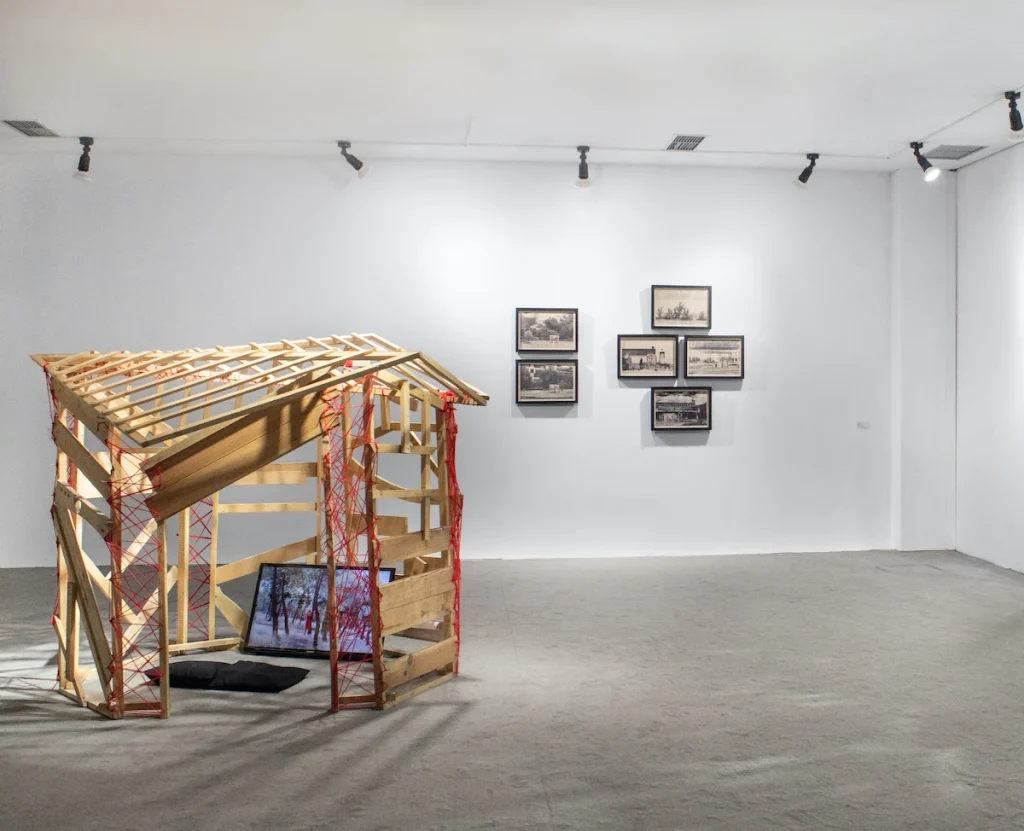
You’re working a lot with wood, and it seems like the materials play an important part in your project. Can you develop a little on that?
Yes, the choice of materials is really important to me when it comes to trying to connect these elements from different time periods. Wood is a material that I really like, and that I’ve been working with in projects before. I use wood as my main material, and then I’m transferring images on it. I use black and white images, as as ressemblance of the past; but on top of that I add colours. I’m using these vibrant colours, and other elements, like pink neon lights, golden tubes… These are materials from nowadays.
Berlin seems like a good choice for such a project, as it is a city where you can really feel the past and present coexisting. Do you think it has a particular impact on your work?
I’m not sure actually, because I still don’t understand the city very well. You can see a lot of these fractures in time, more in other cities of Europe that I’ve visited, like, you can see how certain parts of the city have been destroyed and rebuilt, but I think it’s too soon for me to say how it really is impacting my practice.
Thank you for your time! And lastly, what motivated you to come to GlogauAIR?
I had a friend that used to work at GlogauAIR when he arrived in Berlin eight years ago, so that’s how I learnt about it in the first place. I’ve always wanted to visit Berlin and experience the art scene here from the inside. I did another art residency in Germany in Leipzig in 2019, but I couldn’t go to Berlin at that time. I saw the opportunity at GlogauAir and thought, “now is the time”. Everything happens at the right moment.
Statement
Lives and works in Madrid, ES
My interdisciplinary practice involves sculpture, painting, printmaking, textile, video and photography. My process is additive, which means I work in layers, and in each layer I use a new medium, thus increasing the complexity of the piece. I always start with a photograph, which I work on digitally and then transfer to fabric or wood.
In my recent artwork, I seek a dialogue between two worlds by using ancient everyday objects, which are loaded with history, interweaving them with contemporary textures and vibrant colors. By putting these objects in current context, I offer new insights linking the past with our contemporaneity to reflect on the different meanings that things had and will have over time.
GlogauAIR Project
In ‘Poetics of the Ordinary,’ I bring exquisite porcelain objects from the 17th to the 19th centuries, and place them in a modern context by juxtaposing them with everyday objects from our time. Inspired by the collections of the Kunstgewerbemuseum and the Ethnologisches Museum, I seek to connect with the memories and imaginations that these objects evoke.
Through photography and mixed media techniques like transfer, drawing and painting on wood, I merge the antique with the present, the real with the representation, and mass production with the unique and unrepeatable. The result is an artwork characterized by bold and striking colors that invite viewers to engage in a dialogue between its history and the present.
Installation and Sculpture
CV Summary
Education (selection)
- 2017 MFA, Complutense University of Madrid, Madrid, ES
- 2010 Bachelor of Architecture, Valparaíso University, Valparaíso, CL
Solo Exhibitions
- 2021 To feel lonely you don’t need to run away to the forest, curator Gabino Busto Hevia, Eduardo Úrculo Municipal Art Gallery of Langreo, Langreo, ES (catalogue)
- 2021 A pending conversation, two solo show with Daniel Schweitzer, Navel Art, Madrid, ES
- 2019 Somewhere between up and down, Alfama Madrid, Madrid, ES
- 2019 Here and Gone, two solo show with Christopher Kanyusik, 3Quarters, Atenas, GR
- 2017 The Beagle’s long voyage, curator Joan Feliu Franch, two solo show with MasauR, ECO Les Aules, Castellón, ES (catalogue)
- 2016 Body Architectures, curator Marisol Salanova, Aravaca Cultural Center, Madrid, ES (catalogue)
Group Exhibitions (selection)
- 2022 Feminart, Est-art Space Gallery, Alcobendas, ES (catalogue)
- 2021 Construction time again, Est-art Space Gallery, Alcobendas, ES
- 2020 EAC 2020, XX Contemporary Art Encounter Competition, Sala Sampere, University of Alicante Museum Alicante, ES (catalogue)
- 2020 XXXVI Exhibition of young art in La Rioja, ESDIR exhibition space, Logroño, ES (catalogue)
- 2019 Sculto Contemporary Sculpture Art Fair, curator AliciaVentura Bordes, Inma Prieto, Rogelio López Cuenca, Galería Est-Art Space, Logroño, ES (catalogue)
- 2019 VII Mardel Visual Arts Award 2019, Centre del Carme museum,Valencia, ES (catalogue)
- 2019 Reset Unsettling Flesh Layers, curator Patricia Brien, Alte Handelsschule, Leipzig, DE
- 2019 3rd Biennale di Genova – International Contemporary Art Exhibition, curator Mario Napoli, Flavia Motolese, Genova, IT (catalogue)
Award and grants (selection)
- 2020 Art Nalón Award 2020, Langreo, ES
- 2019 Sculpture-Network Award, Sculto Contemporary Sculpture Fair, Logroño, ES
- 2019 Residency abroad for young artists in the field of visual arts Grant, Madrid Regional Government, ES
- 2017 Casa de Velázquez Specific Aid Grant, Casa de Velázquez, Madrid, ES
- 2016 Culture Funds for Circulation, FONDART, Chile Govermment, CL
- 2015 Production Award, Bilbao Art Foundation, Bilbao, ES
Gallery
